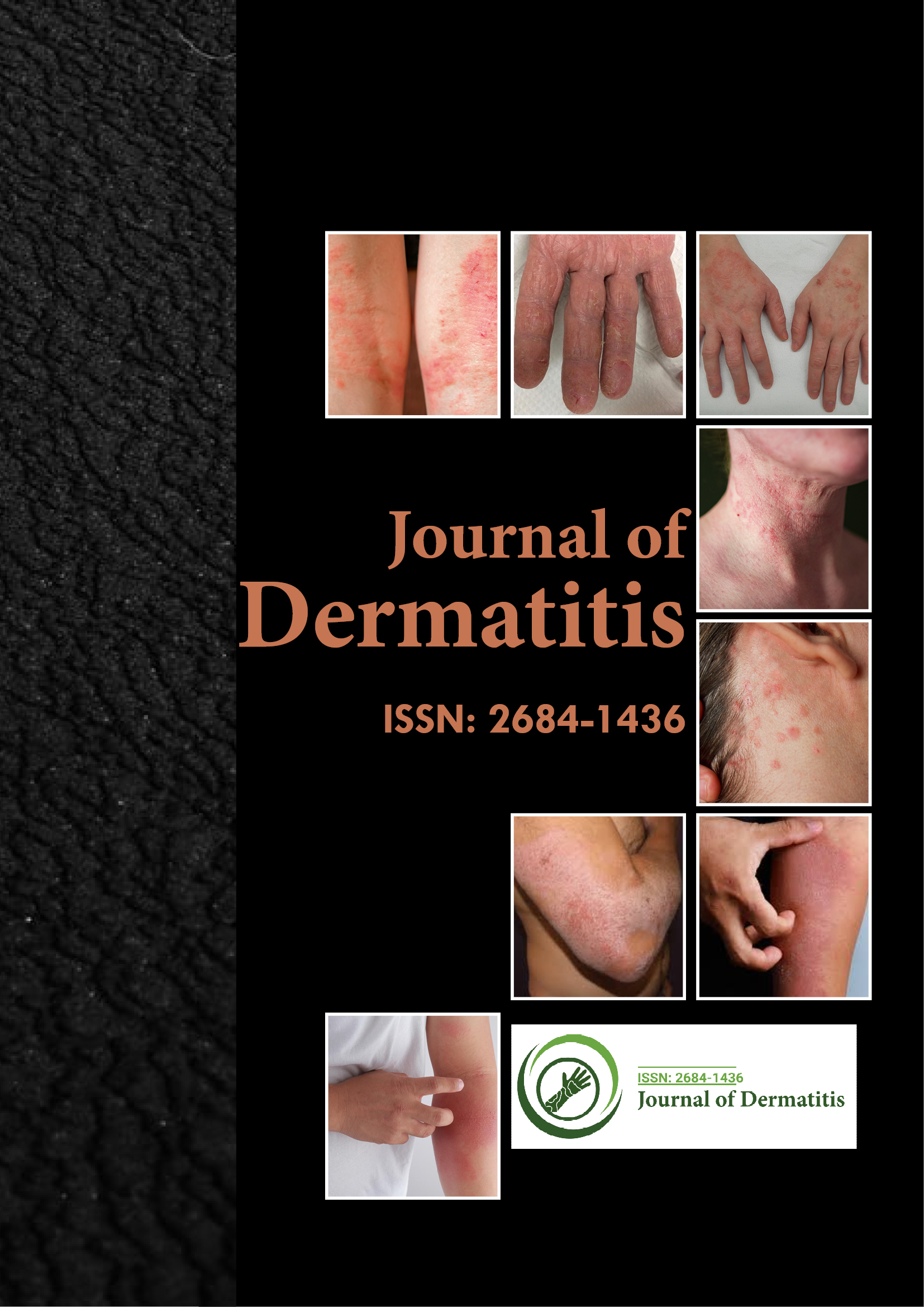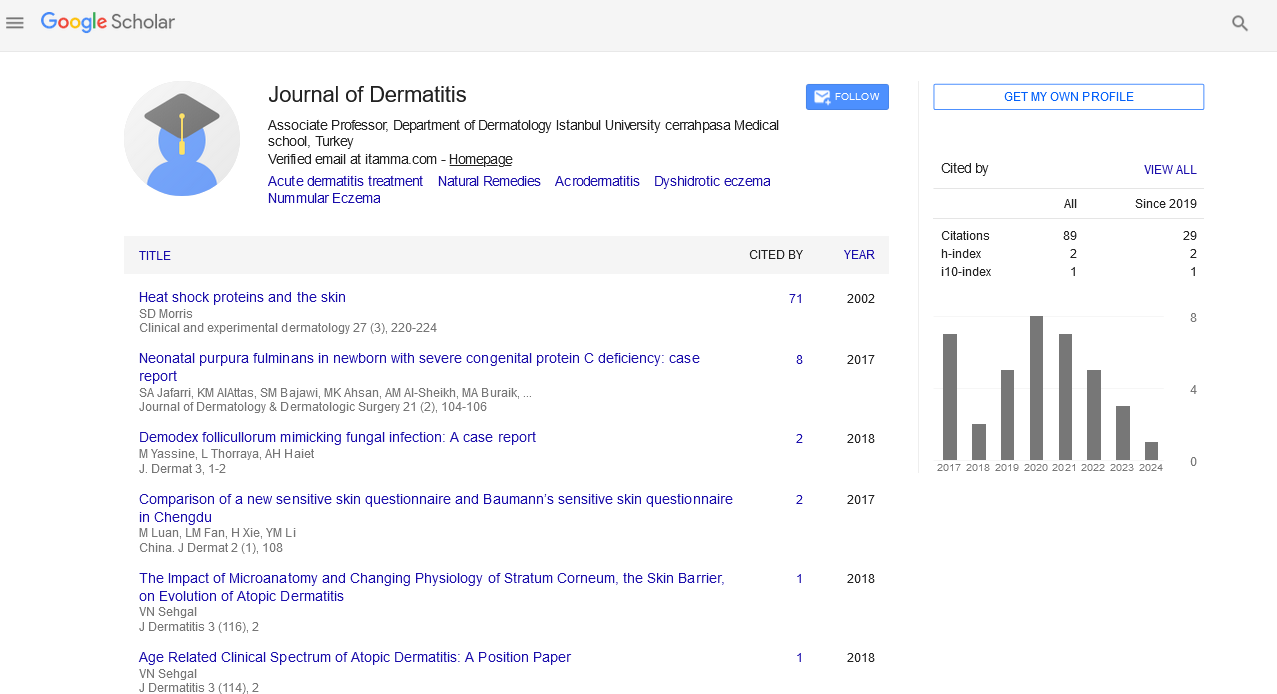Indexed In
- RefSeek
- Hamdard University
- EBSCO A-Z
- Euro Pub
- Google Scholar
Useful Links
Share This Page
Journal Flyer

Open Access Journals
- Agri and Aquaculture
- Biochemistry
- Bioinformatics & Systems Biology
- Business & Management
- Chemistry
- Clinical Sciences
- Engineering
- Food & Nutrition
- General Science
- Genetics & Molecular Biology
- Immunology & Microbiology
- Medical Sciences
- Neuroscience & Psychology
- Nursing & Health Care
- Pharmaceutical Sciences
Commentary - (2023) Volume 8, Issue 2
Topical Strategies for Better Management of Skin Allergy
Yih-Fang*Received: 01-Mar-2023, Manuscript No. JOD-23-20850; Editor assigned: 03-Mar-2023, Pre QC No. JOD-23-20850 (PQ); Reviewed: 20-Mar-2023, QC No. JOD-23-20850; Revised: 27-Mar-2023, Manuscript No. JOD-23-20850 (R); Published: 03-Apr-2023, DOI: 10.35248/2684-1436.23.8.189
Description
Atopic dermatitis, also known as eczema, is a chronic and recurring skin condition that affects millions of people worldwide. It is characterized by dry, itchy, and inflamed skin that can be red and flaky. The severity of the condition can vary from mild to severe, and it can have a significant impact on a person's quality of life. Topical management of atopic dermatitis is an important part of its treatment, and optimizing this management can help improve outcomes for patients. The goals of topical management for atopic dermatitis include reducing inflammation, relieving itching, preventing infection, and restoring the skin's barrier function. The following are some strategies for optimizing topical management of atopic dermatitis.
Use of emollients
Emollients, also known as moisturizers, are an essential part of the management of atopic dermatitis. They help to restore the skin's barrier function and reduce dryness and itching. Emollients should be applied frequently, at least two to three times per day, and immediately after bathing to lock in moisture. There are many different types of emollients available, and patients should be advised to choose one that is appropriate for their skin type and severity of atopic dermatitis. Thicker emollients, such as ointments, are usually more effective than lighter ones, such as lotions or creams, in severe cases.
Topical corticosteroids
Topical corticosteroids are a standard treatment for atopic dermatitis. They work by reducing inflammation and itching. However, they should be used with caution, as overuse can lead to side effects such as skin thinning, stretch marks, and increased risk of infections. Topical corticosteroids are available in different strengths, and the strength should be chosen based on the severity of the atopic dermatitis. In general, lower-potency corticosteroids should be used for mild cases, while higherpotency ones are reserved for severe cases.
Topical calcineurin inhibitors
Topical calcineurin inhibitors, such as tacrolimus and pimecrolimus, are an alternative to topical corticosteroids for the management of atopic dermatitis. They work by suppressing the immune response that causes inflammation. Topical calcineurin inhibitors are generally reserved for moderate to severe cases of atopic dermatitis, and they should be used with caution in patients with a history of skin cancer or lymphoma. They may also cause a burning or stinging sensation when applied, especially on sensitive areas such as the face.
Wet dressings
Wet dressings, also known as wet wraps, can be used to soothe and hydrate the skin in severe cases of atopic dermatitis. They involve applying a layer of emollient or medication to the affected area, followed by a wet bandage or cloth, and then a dry bandage or cloth on top. Wet dressings can be left on for several hours or overnight, and they can be particularly effective in reducing inflammation and itching. However, they can be timeconsuming and require a significant commitment from the patient and their caregiver.
Antibiotics
Antibiotics may be necessary if there is a bacterial infection present in the affected area. Bacterial infections can occur when the skin barrier is compromised, as is the case in atopic dermatitis. Antibiotics may be prescribed orally or topically, depending on the severity of the infection. It is important to note that antibiotics should only be used when there is a bacterial infection present, as overuse can lead to the development of antibiotic-resistant bacteria.
Citation: Fang Y (2023) Topical Strategies for Better Management of Skin Allergy. J Dermatitis.8:189.
Copyright: © 2023 Fang Y. This is an open-access article distributed under the terms of the Creative Commons Attribution License, which permits unrestricted use, distribution, and reproduction in any medium, provided the original author and source are credited.

